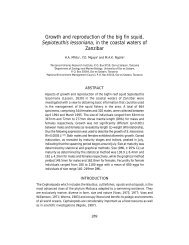gpa_east_africa_case.. - GRID Africa GeoPortal - UNEP
gpa_east_africa_case.. - GRID Africa GeoPortal - UNEP
gpa_east_africa_case.. - GRID Africa GeoPortal - UNEP
You also want an ePaper? Increase the reach of your titles
YUMPU automatically turns print PDFs into web optimized ePapers that Google loves.
Pollution load to surface water resources (kg/day)TypeIndustrialEffluent Pit latrines SepticWithoutfacilities TotaltanksBOD 28,330 15,282 3,275 9,897 56,784COD 29,904 16,131 3,457 10,447 49,776Suspended solids 47,216 25,470 5,458 16,495 78,429Dissolved solids 83,940 45,280 9,830 29,325 138,923Total N 4,145 2,236 479 1,448 6,859Total P 787 425 91 275 1,302Source: Managing sustainable growth and development of DSM by SDPA survey of groundwater quality from a number of boreholes drilled in 1980 concluded that itshigh salinity excluded if from being considered as a potable resource. The salinity probablyresulting from the leaching of the predominantly saline sand / clay geology of the region ratherthan saline intrusion. The majority of groundwater resources within the built up area are alsocontaminated as a result of poor sanitary arrangements, with more than 118,822 tons ofpolluted water discharged to the ground daily. Projected 1991 pollution loads from landsources included 68tons BOD, 7tons COD, 147tons Suspended Solids, 219tons DissolvedSolids, 21tons of total Nitrogen and 33tons of total Phosphorus; which result in high nutrientsand suspended solids loads, as well as occurrences of pathogens at places where freshexcreta are released. The high levels of nitrogen and phosphorus result in algae andseaweed blooms, the decay of which combined with accumulated suspended matter on theforeshore could give rise to the pungent odours occasionally experienced at low tide in thevicinity of the salender bridge and along ocean road.Pollution load to groundwater Resources (kg/day), 1991 ProjectionsSeptic Sewer Losses Total (tons)Type No facility Pit latrines tanks Domestic industryBOD 1,100 15,282 7,641 1,221 1,899 27COD 1,161 16,131 8,068 1,289 1,1994 29Suspended1,833 6,116 3,832 2,035 3,148 18SolidsDissolved3,258 97,857 61,128 3,618 5,596 196SolidsTotal N 120 4,829 3,018 3,618 5,596 10Total P 23 915 572 34 52 2Source: Managing sustainable growth and development of DSM by SDPShallow and deep wells are used to provide variable qualities for washing rather than drinkingwater. More than 18,000 people relying on groundwater from 144 shallow wells in 52 periurbanvillages. Many industrialists also supplement the city supply with their own deep wells.There are 51 such wells recorded within the city boundaries.The results of a survey in 1988 on quality of coastal waters (Managing sustainable growthand development of DSM by SDP) suggesting that:• The conductivity to be rather low for ocean water, indicating the presence of fresh waterdilution.• Whilst both BOD and COD were low, the most probable number of F-Coli was high at30,000/100ml, as was the MPN of total Coli counted at 600,000/100ml suggesting seriousbacteriological pollution.• The relatively high-suspended solids could result from pollution.• Low Ammonia Nitrogen but high Kjeldahl nitrogen evidenced eutrophications as did loworthophosphate levels.1n 1999, NEMC conducted a rapid assessment of Msimbazi river around VingungutiDumpsite (Report on Situation around Vingunguti Crude Dump by NEMC, 1999). It wasobserved that at very place people utilizes river water for domestic and agricultural purposesincluding fishing, feeding animals, washing clothes, irrigating vegetables etc. while the riverFinal Draft Report – Cost Benefit Case StudiesGPA Strategic Action Plan on Sewage, October, 200084



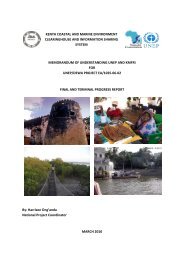
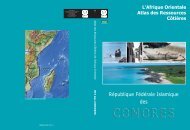
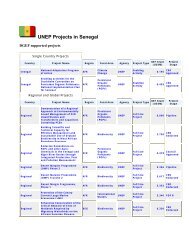

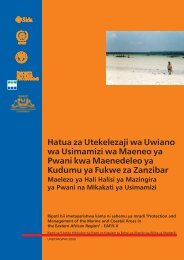
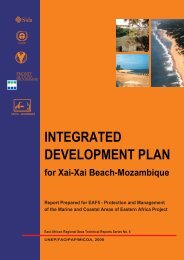
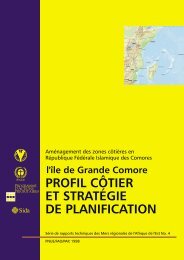
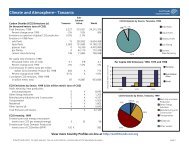

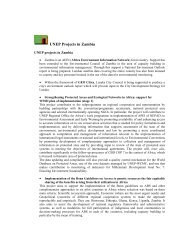
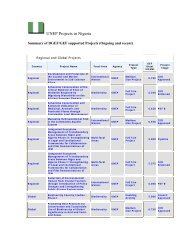
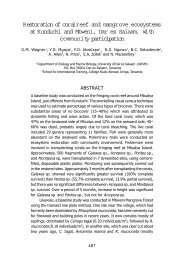
![Please Click to download [English] - GRID Africa GeoPortal - UNEP](https://img.yumpu.com/30633391/1/184x260/please-click-to-download-english-grid-africa-geoportal-unep.jpg?quality=85)
